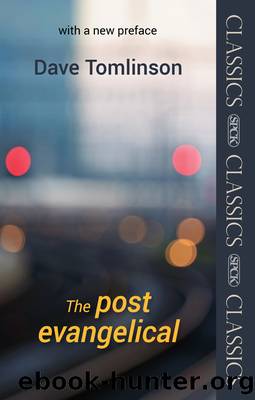The Post-Evangelical by Dave Tomlinson

Author:Dave Tomlinson
Language: eng
Format: epub
Publisher: SPCK
6
âLet me tell you a storyâ
We have already touched on the subject of postmodernism and we now need to look at this a little more closely. I have referred several times to the fact that the Western world is in a state of flux and that the modern world, stretching back to the Enlightenment, is now crumbling. It has far from disappeared and is unlikely to do so for a very long time, but serious cracks are growing in all directions, and out of the cracks of this crumbling culture a new postmodern world is emerging. It is a world which understands itself through biological rather than mechanistic models; a world where people see themselves as belonging to the environment, rather than over it or apart from it; a world distrustful of institutions, hierarchies, centralized bureaucracies and male-dominated organizations. It is a world in which networks and local grass-roots activities take precedence over large-scale structures and grand designs; a world in which the book age is giving way to the screen age; a world hungry for spirituality, yet dismissive of systematized religion.1 It is a world in which image and reality are so deeply intertwined that it is difficult to draw the line between the two.2
Those who think that postmodernism is a figment of the academic imagination, a passing intellectual fad, could not be more wrong. Postmodernism has flowed right out of the musty corridors of academia into the world of popular culture; it is on the pages of youth magazines, on CD cases and the fashion pages of Vogue.3 It has abolished the old distinction between âhighâ and âlowâ art, and created new art forms out of things like music videos, urban graffiti and computer graphics. Few things could, in fact, sum up the postmodern situation better than the term âvirtual realityâ, for it is a world in which the old certainties are dissolving.
My thesis is simple: that post-evangelicals tend to be people who identify culturally more with postmodernity (the culture of the postmodern) than with modernity, and that this has a significant bearing on the way that they approach and understand the Christian faith. I am not suggesting that they accept blindly whatever the new culture throws at them; indeed, one of the greatest challenges facing post-evangelicals is the task of undertaking a critique of the world they inhabit, and deciding what is and what is not amenable to the Christian faith.
A world of different stories
One of the most helpful ways of thinking about the distinction between the worlds of the modern and the postmodern is to think of them as stories or narratives â versions of reality. The modern or Enlightenment version of reality, which for a long time has been the âauthorizedâ version, can be thought of as a âbigâ story or epic, which tries to tell us everything. It not only tells us how things are but how they were and how they should be; it explains the whole thing â from a particular angle. Such stories abounded in the nineteenth century as the modernist world view flourished.
Download
This site does not store any files on its server. We only index and link to content provided by other sites. Please contact the content providers to delete copyright contents if any and email us, we'll remove relevant links or contents immediately.
Killing Kryptonite: Destroy What Steals Your Strength by John Bevere(46)
Vertical Church by James MacDonald(38)
Free Will Revisited by Picirilli Robert E.;(27)
The Post-Evangelical by Dave Tomlinson(23)
You Lost Me Discussion Guide by David Kinnaman(22)
The Navigator by Issue 29-Focus-on-Pilots(19)
Godâs Shining Forth by Hay Andrew R.;Davidson Ivor J.;(18)
A Theology of Nonsense by Gabelman Josephine;Milbank John;(16)
CHRISTIAN PERFECTION by Unknown(9)
Mystic Treatises by Isaac of Nineveh by A.J. Wensinck(8)
